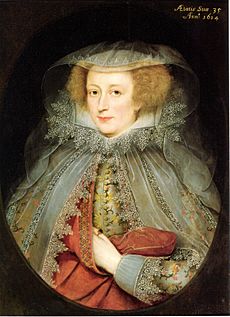Marcus Gheeraerts the Younger facts for kids
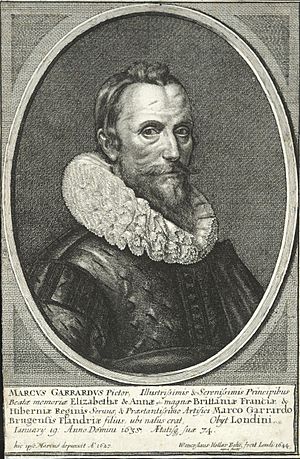
Marcus Gheeraerts (sometimes called Gerards or Geerards) was a very important painter in England. He lived from about 1561 or 1562 to 1636. He is known as one of the best artists to work in England during the time of the Tudor and Stuart kings and queens.
Marcus came to England as a child with his father, who was also a painter. He became a popular artist for painting portraits, especially during the last years of Queen Elizabeth I's rule. He was supported by Sir Henry Lee, who organized many court events. Marcus Gheeraerts brought a new style of painting to England. He made portraits look more real by carefully observing people. He also became a favorite painter for King James I's wife, Queen Anne. However, his style became less popular around 1610.
Contents
About Marcus Gheeraerts' Family
Marcus Gheeraerts the Younger was born in a city called Bruges. His father, Marcus Gheeraerts the Elder, was also an artist. We don't know much about the elder Gheeraerts' paintings. But he was famous in Europe for making prints.
Moving to England
The Gheeraerts family were Protestants. Many Protestant artists from the Netherlands had to leave their homes. They were escaping persecution during the rule of the Duke of Alba. So, Marcus the Elder and his son came to England. Marcus's mother was Catholic and stayed behind. She probably died a few years later.
In 1568, Marcus and his father were living in London. In 1571, his father remarried. His new wife was Susanna de Critz. Her family had also left their home city of Antwerp.
His Training and Own Family
We don't know for sure who taught young Marcus to paint. It was probably his father. He might also have learned from an artist named Lucas de Heere. Records show that Marcus was working as a painter by 1586.
In 1590, Marcus married Magdalena. She was the sister of his stepmother Susanna. Magdalena was also the sister of another painter, John de Critz. Marcus and Magdalena had six children. Only two of them lived to be adults. They were a son named Marcus III, who also became a painter, and another son named Henry. Marcus's half-sister Sara married the painter Isaac Oliver in 1602.
Marcus Gheeraerts' Career as an Artist
A New Way to Paint Portraits
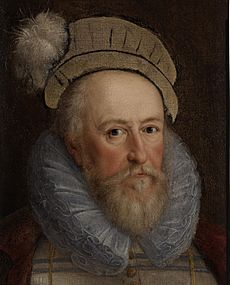
The first paintings signed by Marcus Gheeraerts the Younger are from around 1592. However, some experts believe he painted portraits of William Cecil, 1st Baron Burghley around 1586. Even though Marcus grew up in England, his art looked different from other English painters. His style was more like artists from mainland Europe.
Before Gheeraerts, English portraits often looked flat. Colors were very bright. But Gheeraerts changed things around 1590. He made people look more real, like they had depth. He used shadows and different tones of color. He also tried to show the true personality of the people he painted. His colors were often darker and more serious.
Gheeraerts was one of the first English artists to paint on canvas instead of wood. This allowed him to create much larger pictures. He also started painting full-length portraits of people outdoors. They were shown in natural landscapes. This was a new idea for big paintings, though it was already seen in tiny miniature portraits.
Gheeraerts likely had a workshop with assistants. They would help him paint backgrounds and small details. Many copies of his works exist, which also suggests he had a team. He worked closely with his brother-in-law, Isaac Oliver. They painted similar portraits of people like Robert Devereux, 2nd Earl of Essex and Queen Anne. It's not clear if they worked together or just shared ideas.
Success with Queen Elizabeth I
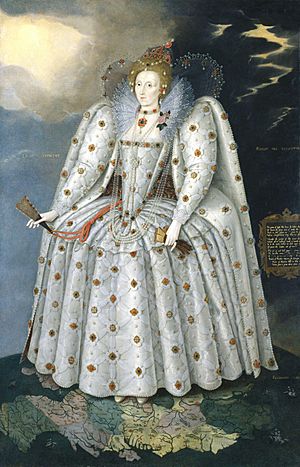
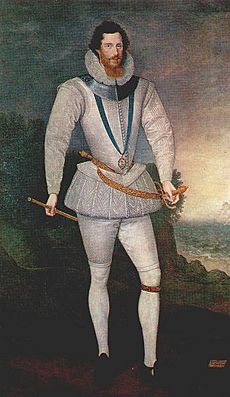
Sir Henry Lee was a very important person at Queen Elizabeth I's court. He organized many grand events and shows. Sir Henry Lee became Gheeraerts' supporter around 1590. Soon, Gheeraerts became very popular in the queen's court. He painted special portraits that fit with the fancy costumes and symbols of Lee's events.
The queen herself probably posed for him for the famous Ditchley Portrait in 1592. This painting shows her standing near Sir Henry Lee's home in Ditchley. Her favorite, the Earl of Essex, also hired Gheeraerts from 1596. Official records from 1596-1598 show payments to "Marcus Gerarde" for his art. Another portrait of Queen Elizabeth by Gheeraerts is at Trinity College, Cambridge.
The Ditchley Portrait was likely painted to celebrate the queen's visit to Ditchley in 1592. In this painting, the queen stands on a map of England, with her feet on Oxfordshire. The painting has been changed over time, and parts of it are missing. Storms are shown behind her, but the sun shines in front. She wears a jewel shaped like a celestial sphere near her ear.
The queen didn't always like Gheeraerts' very realistic style as she got older. So, in many copies of this painting, her face was made to look "softer." These copies were probably made in Gheeraerts' workshop. One of these was sent as a gift to the Grand Duke of Tuscany and is now in Italy.
Around 1594, Gheeraerts painted a portrait of Sir Henry Lee's cousin, Captain Thomas Lee. This painting shows him in a landscape, wearing Irish clothes. The painting hints at Captain Lee's work in Ireland. Gheeraerts also painted several portraits of Sir Henry Lee himself. One shows him in his special robes from the Order of the Garter in 1602.
The Earl of Essex (whose mother was related to Sir Henry Lee) seemed to use Gheeraerts only for large portraits from the mid-1590s. One of these is a full-length painting from 1596. It shows Essex in a landscape with the burning city of Cadiz in Spain in the background. Many other portraits of Essex, showing him from the waist up or three-quarters length, were likely made in Gheeraerts' workshop. Like Sir Henry Lee, Essex was important in the queen's special events.
Art expert Sir Roy Strong said that Gheeraerts was successful because he mixed the strong style of Flemish painting with the elegant, thoughtful style of late Elizabethan England. He believed the portraits of Queen Elizabeth and Essex are Gheeraerts' best works. They are considered masterpieces of early English painting.
Gheeraerts' popularity did not seem to suffer even though he painted people involved in the Essex Rebellion. (Both Essex and Thomas Lee were executed for treason in 1602).
Working for King James I's Court
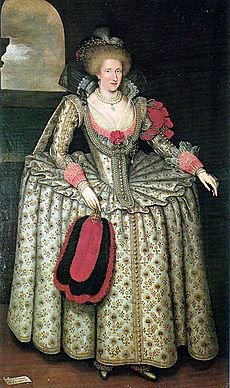
Gheeraerts remained a popular artist right after Queen Elizabeth's death in 1603. King James I's wife, Queen Anne, hired Gheeraerts for her large paintings. Her miniatures were painted by his brother-in-law, Isaac Oliver. In 1611, Gheeraerts was paid for portraits of the King, Queen, and Princess Elizabeth. A painting of Queen Anne, possibly in mourning for her son Henry Frederick, Prince of Wales, is also thought to be by Gheeraerts.
In 1611, he painted Frances Howard, Countess of Hertford. She is shown in rich clothes, framed by silk curtains. This was the first time this kind of background was used in a portrait. Later, another painter named William Larkin used this style. Gheeraerts' paintings from this time often show a calm, thoughtful, and gentle mood. You can see this in his portraits of Catherine Killigrew, Lady Jermyn (1614) and Mary Throckmorton, Lady Scudamore (1615).
Isaac Oliver died in 1617. Around the same time, Gheeraerts' importance at court began to fade. New artists from other countries were becoming popular. Queen Anne of Denmark died in 1619. Even though Gheeraerts was part of her funeral as "Queen's Painter," another artist named Paul van Somer had probably taken his place as her main portrait painter earlier. For the last 20 years of his life, Gheeraerts mostly painted for country nobles and scholars.
Gheeraerts was a member of the Painter-Stainers' Company in the 1620s. He had an apprentice named Ferdinando Clifton. Marcus Gheeraerts died on January 19, 1636.
Gallery
Elizabethan Era Paintings
-
Portrait of William Cecil, 1st Baron Burghley, painted after 1585. This oil painting on wood is thought to be by Gheeraerts. It is at the National Portrait Gallery, London.
-
Sir Francis Drake, 1591.
-
Portrait of an Unknown Woman from 1590-1600. This oil painting on canvas is at the Royal Collection, Hampton Court. It was once thought to be a pregnant Queen Elizabeth I.
-
Portrait of an Unknown Lady, around 1595. It might be Lettice Knollys, Countess of Leicester.
-
Robert Devereux, 2nd Earl of Essex in his Garter robes, around 1597, National Portrait Gallery, London.
Jacobean Era Paintings
-
Tom Durie, Queen Anne of Denmark's jester, 1614, oil on wood. It is at the National Galleries of Scotland.
-
Margaret Laton, around 1620, Victoria and Albert Museum.
-
Susanna Temple (sister of James Temple), 1621, oil on canvas. It was sold in 2000.
See also


